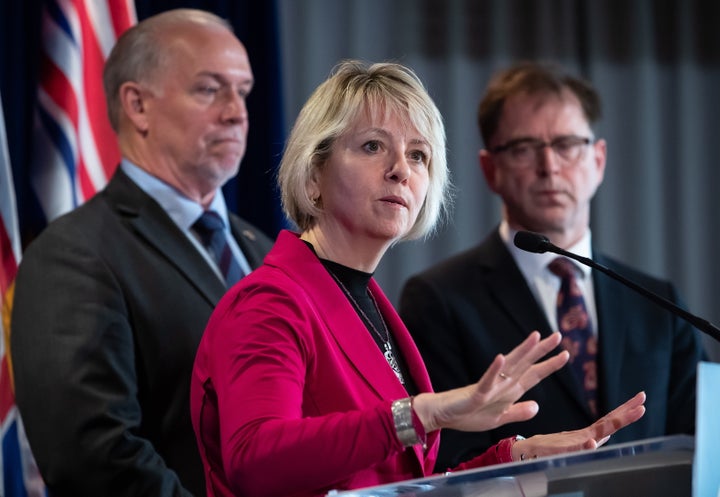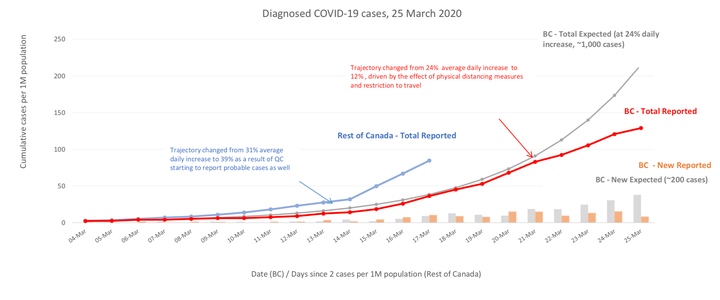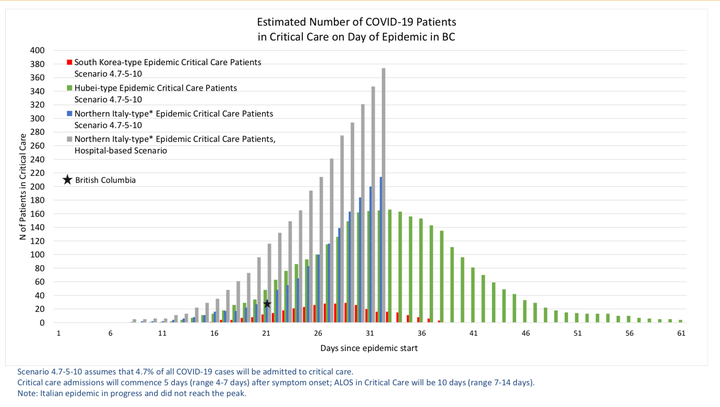VICTORIA — British Columbia chief public health officer Dr. Bonnie Henry said Friday she is “cautiously optimistic” the province’s COVID-19 curve is starting to flatten, but warned the health-care system must still prepare for the worst-case scenario.
“Our trajectory has levelled off a bit, we need to see that continue,” Henry said. “It’s going to save communities.”
The province released a series of statistical models Friday projecting B.C.’s confirmed COVID-19 case-number trajectory and hospital capacity in comparison to various jurisdictions around the world.

The models show the health-care system capacity needed should the pace of B.C.’s infections start to resemble some of the hardest hit areas by the COVID-19 pandemic including Hubei, China and northern Italy. As of March 26, B.C. currently has 725 confirmed cases of COVID-19, including 14 deaths and 186 recovered cases.
But despite doing everything to prepare, officials say social distancing could be working to keep B.C.’s case numbers down and hospital demand lower than in those worst-case scenarios.
“There’s a slight chance of optimism perhaps, that our rate of growth is being impacted by the measures we’ve put in in the last few weeks,” Henry said.

As of March 26, B.C. currently has 725 confirmed cases of COVID-19, the disease caused by the novel coronavirus, including 14 deaths and 186 recovered cases.
Starting on March 12, the province began implementing serious measures, including shutting down restaurants, closing schools and travel restrictions as well as encouraging individual social distancing. Henry says there is evidence that those strategies have worked at limited numbers of confirmed cases.
“I do believe we’ve seen a flattening, a falling off of that curve,” Henry said.
The province is currently reporting around 130 cases per million people in B.C., while pre-social distancing projections suggested there would be 230 per million people in the province at this point.
“I do believe we’ve seen a flattening, a falling off of that curve.”
- Dr. Bonnie Henry
Henry said she can’t confirm how many total cases could be present in the province, but the projections suggest there could be 2,000 to 3,000 people currently infected in B.C. As time passes since social distancing measures were implemented, that number will ideally go down, she said.
Still ready for the worst case scenario
But Henry said despite this “cautious optimism,” the province is still preparing its health-care system for every possible scenario.
On Friday, B.C. Health Minister Adrian Dix outlined how B.C.’s Centers for Disease Control and local health authorities are modelling and preparing for various levels of outbreak.
“If it gets serious, we are preparing the worst possible scenario, regardless of if it’s the most possible scenario or not,” Dix said.
The modelling outlined four possible scenarios for the province:
- South Korea, which is internationally regarded as the benchmark for successfully “flattening the curve”
- Hubei, China, where the virus originated and now appears to be under control
- Northern Italy’s confirmed case rate
- Northern Italy’s hospitalization rate, which has spiked dramatically due to lack of capacity in the health system
Dix said the two different scenarios for Italy are designed to capture the absolute worst-case scenario where a health-care system is overwhelmed.

The province has identified 17 major B.C. hospitals as designated COVID-19 treatment centres. Officials say they plan to house ICU and acute care COVID-19 patients in these hospitals. Dix said spaces like cardiac recovery sites and post-anesthesia recovery rooms are being prepared to house COVID-19 patients in these hospitals as necessary, though current projections don’t necessitate that.
Dix said these projections are based on the assumption that 4.7 per cent of cases need critical care,13.8 per cent need hospitalization but not critical care and that 80 per cent of critical care cases will require ventilators. The assumptions were derived from current case statistics in the province and country.
“We are preparing the worst possible scenario, regardless of if it’s the most possible scenario or not.”
- Health Minister Adrian Dix
In a worst-case scenario, other hospitals outside of those 17 major centres can also open up capacity for COVID-19 patients as necessary.
Ventilator capacity looks “good”
Officials said that after a series of ventilators — devices that assist patients with breathing — on order and out for repair arrive next week, the province will have 1,344 ventilators total on hand. Dix said those ventilators will be distributed in the parts of the province projected to need them most.
The health minister stressed that even estimating on the higher end, B.C.’s curve is most likely to be at or below that of Hubei — a number the province is prepared to handle in those 17 centres without overwhelming the health-care system.
“Using the likely scenario of a Hubei-epidemic level, capacity looks good,” Dix said in reference to both ventilator capacity and hospital bed capacity.
He said if B.C. epidemic levels reach that of northern Italy, the province is preparing to move non-critical patients out of hospital to other locations such as acute care homes to make room for more serious COVID-19 patients.
“We are absolutely determined to have the best results, [but] we are preparing for the worst possible scenario,” Dix said.
Henry also stressed that the province is prepared for the worst.
“If we do this right, it is what's going to save us.”
- Dr. Bonnie Henry
“Even if we’re in a situation like what’s being seen in Italy right now, the planning should allow us to adequately care for everyone,” Henry said.
But ultimately, Henry says people in the province should stay the course with social distancing and “double down on what we’re doing,” because it is likely working to keep B.C.’s infection curve low.
“If we do this right, it is what is going to save us,” Henry said.
“Social distancing is making a difference, and it will continue to make a difference in the coming months.”
Also on HuffPost: